J.C.J. (JOHN) KNOTT
Please be aware that some specialist imagery may take time to load.
This site is designed for dedicated researchers, and is best viewed on desktop.
See also: ......Knott's Pattern '13 Enfield ...... - ......BSA Small-bore rifles
His career in rifle shooting and manufacture,
and the 1948 Olympic British Team's Free Rifle
Plus - five facsimile documents of his 1950 journal "THE MARKSMAN"
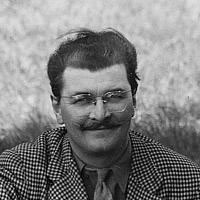
John Colin James Knott - photographed in 1947
Probably best known for his involvement in the production of the Centre-Fire High Power rifle used by the British Team in the 1948 Olympic Games,
Knott was a keen sporting shooter, with considerable experience in game shooting and with many rifle types,
but his expertise also ran effectively through the world of small-bore target shooting.
This latter part of his varied shooting career in the U.K. is what brought him to the attention of our research.
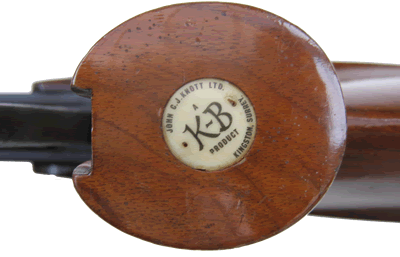
His business, known as "John C.J Knott Ltd.", of Kingston-upon-Thames in Surrey,
was in premises not far from where he was born in Epsom in 1914,
and the firm assembled rifles in conjunction with his contemporary, S. Broughton,
another successful shooter and member of the Ham & Petersham Rifle Club near London.
The resultant company motif "K-B" is illustrated right.
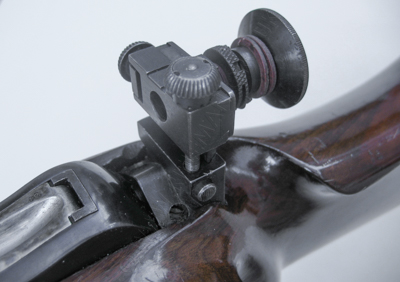 Over the years of his small-bore rifle production,
Over the years of his small-bore rifle production,
Knott used BSA Martini actions and barrels,
as well as Mauser bolt actions.
His specialist stocking brought to his doors those with very
specific requirements in the specifications of their target rifles.
Knott's rifles were not without success in competition,
and he built a significant reputation on that success.
He was, though, reputed to have been something of a ladies' man,
and not all his contemporaries had the highest opinion of his extra-curricular activities;
although it is said that he was of a highly sociable nature,
and he has been described in that endearing way as a "likeable rogue".
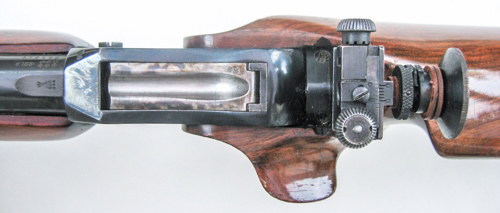
The above rifle is a specially Left-Hand stocked modification of a BSA Model 12/15.
It is fitted with a Parker-Hale No.7A rear-sight and their P-H F22 tunnel foresight with exchangeable elements.
The rear-sight is carefully surrounded by the finely figured woodwork.
Details of this sight are to be found on the BSA Mod. 12/15 page via the link above, or on our page for BSA and Parker-Hale sights and accessories.
The rifle is fully illustrated below.
Hover over or Click image to bring up hi-res file and magnifier
Below: the marking of the barrel for the Birmingham Small Arms Company,
and a rear view of the left-handed stock.
 ...
... 
This rifle is the earliest that we have discovered with a fore-sight fitted with an "Eagle-Eye" type lens.
 ..................
.................. 
The low-power magnifying lens is neatly made to fit this Parker-Hale FS22 tube fore-sight.
It lies immediately in front of what must also be an early example of the perspex
elements only then coming into use with a chamfered aperture picked out in black.
 ............
............ 
The left hand image above is a photograph taken through the fore-sight of a pigeon on a nearby chimney top. This type of lens, nowadays in common use by mnay older target shooters, has become known as the eagle-eye. Usually of around 1.5 to 2 times magnification, it increases the size of the aiming mark and allows a larger fore-sight aperture to be used; but there is a penalty attached of reduction in clarity of the sight picture - a blurring that increases with the level of magnification.
_________________
In 1950, Knott became one of a small team of shooters cum journalists who ventured into the world of publishing.
Their diminutive magazine "The Marksman" was a short-lived monthly journal which was initially published in mid-1950 as a "Specimen Issue".
It was followed up over a period of only a further four months, until its demise with the final issue No.4 (of Volume 1) in November of that year.
The Editor was M.E. Bradfield, and the Art Editor one E.C. Horner.
Many of the articles were either written, or sourced by, an advisory panel consisting of
Captain E.W.H. Brookes, A.J. Foster, J.B. Leslie and John Knott himself.
Below is an image of the cover of the September 1950 issue - Vol.1 No.2.
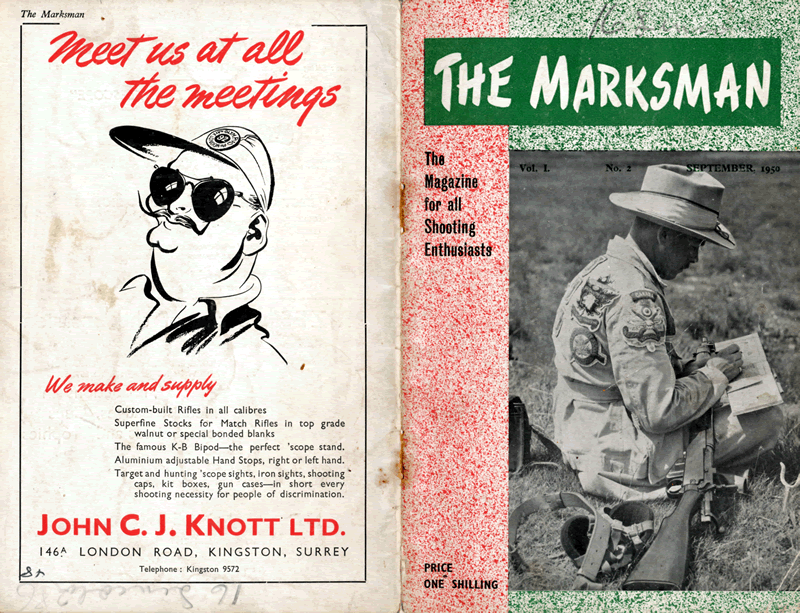
Knott advertised his company with a full-page spread, carrying his prominent characature,
in every one of the five numbers before closure. In the represented issue he took the back cover.
The magazine covered a wide variety of issues, including small-bore, full-bore, pistol and clay pigeon shooting.
Shooting and firearms politics were discussed, and there were a number of articles on both historic and otherwise interesting or unusual arms.
There was even an article on a Browning_Machine_Gun-like Automatic Air-Gun, which was powered by a compressed air cylinder.
It was smooth-bored in .177" calibre, and designed to fire steel shot at a rate of fire of up to 350 shots per minute.
We promised to scan all five issues of "The Marksman", and re-publish them here on-site in PDF format.
Our thanks go to John Anderson who loaned the papers, for the purpose, from his archived collection;
indeed posting them from his new home in North America.
Below is the documentation of the first "specimen" issue for May/June 1950
The remaining four copies of the journal are reproduced at the bottom of this page.
Not only are many of the articles tremendously interesting and revealing, but the contemporary advertisements too!
It is a searchable flip-page facsimile of the journal, may take a few moments to display. N.B. The search magnifier may need to be clicked twice.
N.B. The remaining four copies of the journal are reproduced at the bottom of this page.
One means of discovering something of an individual's life can be to read an obituary written whilst that life is in recent memory.
Fortunatel we were given a copy of Knotts' obituary published in an unknown newspaper 'on the other side of the pond'.
He had emigrated to North America later in life, and died there at a date yet to be confirmed.
Perhaps then, Knott being none too well-known on that continent, the report could be forgiven for implying,
reading between the lines, that at least one thing about his life of which he had spoken,
to those with whom he liased in his new country of abode, may have been taken with a pinch of salt.
AN UNDATED OBITUARY
JOHN C. J. KNOTT
John Colin James Knott, aged 50, English-trained gunsmith and manager of the sporting goods annexe to an Auto Supply Company in Tucson, Arizona, is the description given to John Knott, the British marksman who emigrated to the U.S.A. in 1954. Sadly this newspaper report records his death as a the result of a heart attack. The report was headed ' Rosary Set Tonight for Gun Expert '. John Knott came into the small-bore shooting world in 1946 and very quickly went to the front, being selected to shoot for Britain in the 1947 World Championships in Stockholm. That year, also in 1951, 1952 and 1953, he shot for Great Britain in the Dewar Match. In 1947 he shot for Britain in the Mayleigh Trophy Pistol Match. In 1949 and again in 1951, he shot for Britain in the Wakefield Trophy Match.
His peak performance was to win a place on the British Team which travelled to Camp Perry, Ohio, for the Pershing Trophy Match in 1953. It was from contacts that he made there and the brief taste of American life which fired his enthusiasm to return, and he departed from Britain the following year.
News has come through from time to time that John Knott had pursued his chosen trade as a gunsmith from the business he formed at the bottom of Kingston Hill, Surrey. He claimed to be the maker of the Centre-Fire High Power rifle used by the British Team in the 1948 Olympic Games and on that claim he steadily established himself, producing a small-bore rifle to his own design and retailing several American accessories. Whilst in England, it is said that he built a rifle for film magnate John Huston costing £2,000. At the time of his death he was a Pima County Auxiliary Deputy Sheriff, a member of the Tucson Trap and Skeet, the Tucson Rifle and the Pima Pistol Clubs. His survivors include his wife Maria. The funeral rites at Tucson Mortuary Chapel were on 5 October, mass at St. Agustin Cathedral with burial in the Veterans' Plot in South Lawn Memorial Park.
We are indebted to Vice President Colonel G. Gould, D.S.O., for the information which came to him from a nephew in the U.S.A. via a professor of English Literature at the University of Arizona in Tucson.
Interestingly, there was still mention of John C.J. Knott Ltd., in The London Gazette of 26th. September 1958.
We still seek copy if you can help.
1948 Olympics Summary
Three-Position 300 Metres Free Rifle
This was the final event of the 1948 shooting competition, contested over two days on 5-6 August.
Each shooter took 120 shots, 40 prone, 40 kneeling, and 40 standing, with any rifle of not more than 9 calibre allowed.
The shooting was done at 300 metres, at a one metre target with a black bullseye of 60 cm., the entire target divided into 10 scoring rings.
Most of the European shooters used a short-action bolt rifle, and 6.5 or 7.5 mm. cartridges.
The event was won comfortably by Switzerlandís Emil Grunig, with a score of 1,120 from 1,200 possible.
He was consistent throughout, with the highest score prone, the second highest score kneeling, and the third highest score shot standing.
Details of the 1948 Olympic competition and final standings can be found here on the OLYMPEDIA site
A Mr. Saunders, to whom John Anderson spoke in 2001 (the latter researcher has assisted greatly with material for this page),
was apprenticed to Knott, or another of his colleagues, in 1950.
As far as he remembered Knott "went bust and left the country around 1955" [1954 - Ed].
He said what he knew about Knott before 1950 came from an article in "Shooting Times & British Sportsman" published 3rd April 1948.
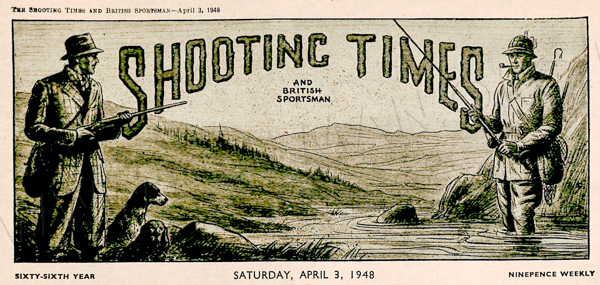
(We have recently located a copy of that article, now shown below as a searchable facsimile).
We have also been kindly afforded photographs, by the fortunate current owner, of one of the 1948 Olympic free-rifles,
and below is the right-hand elevation of this obviously P'14 (Pattern 1914 - Enfield Rifle No.3) based example, with its 3-positional palm rest.

The 300 metre Olympic match in 1948 was a 3-position competition, hence the hand-rest.
Below: the left-hand side

We are advised by its custodian that the rifle weighs in at a significant 17lbs.
To put that in context, a modern target rifle, such as an RPA Quadlock weighs 12.2lbs.
The barrel diameter is 1.25" at the receiver, 1" at the point it exits the stock, and 0.85" at the muzzle.
The stock is packed with wood shims rather than bedded. These can be seen in the following image.
It is not known why a barrel band was thought necessary on a barrel of this magnitude.
This could have been a hangover from service rifle logic, but seems odd in relation to current thinking.
The set trigger is incredibly light - no more than a few ounces - lighter than many smallbore target rifles.
(Indeed, the owner finds it way too light for comfortable use and is seeking some guidance as to how he I might add some weight to it.
At present it seems that the only adjustment offered by the trigger mechanism is to make it even lighter!
It is thought that the trigger is of John Knott's own devising.
At 300m the rifle shoots very well and will comfortably hold the bull on a modern NRA 300m target.
The Birmingham Small Arms Company made a special batch of about 100 barrels, from which the team's half-dozen or so rifles were fitted.
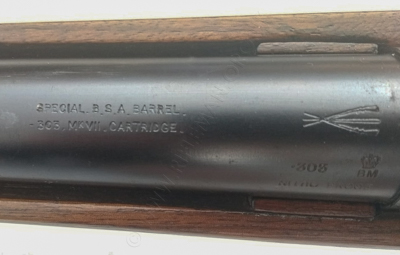
The barrels were not BSA's only contribution, as they were fitted with an otherwise unique fore-sight with exchangeable elements.
This rare, and expensive to manufacture tunnel sight was originally produced for the training/target Lee-Enfield Trials .22" Rifle No.5, the only other usage of which we are aware being on the following experimental .22 Rifle No.6, the precursor to the No.8 trials and issue rifles.
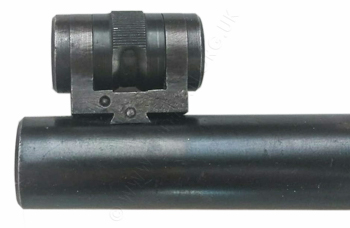 ..................
..................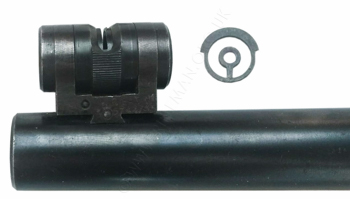
The sight's system of changing elements was probably the quickest and neatest we have ever come across;
The knurled ring is simply rotated through 180 degrees, opening the slot,
when the fitted element can be lifted out and replaced with an alternative, prior to re-locking by turning the ring back.
The trials BSA Enfield rifles were issued with one ring element and one post element.
Sadly, holding collectors of any one of these rare rifles often find
alternative or replacement elements to be akin to hen's teeth; modification of P-H versions being the best recourse.
Compared with the usual BSA or Parker and Parker-Hale method of unscrewing a locking sleeve with half-a-hundred
turns, tipping the rifle to drop out the element and screwing the sleeve back in after the replacement element, this is a delight.
However, later Parker-Hale models did included a similar slot that only required a small number of turns to back off the locking sleeve.
Below: the sight-line of the Olympic Free Rifle, fitted with a standard Parker-Hale No.5B aperture target rear-sight with half-minute clicks.
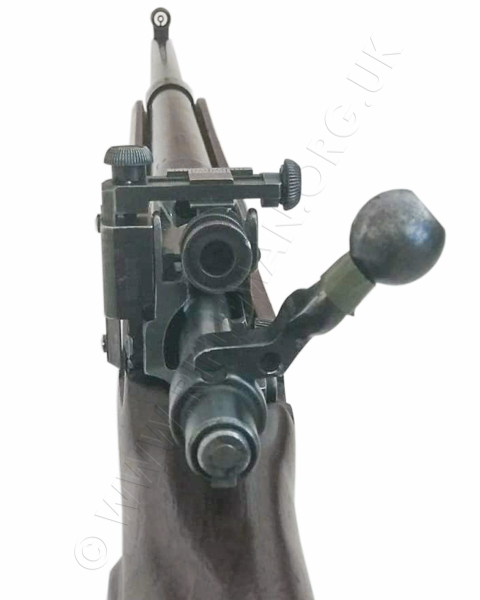
Again, the parentage of the the rifle is very evident as being the P'14 rifle, with its Mauser-based action.
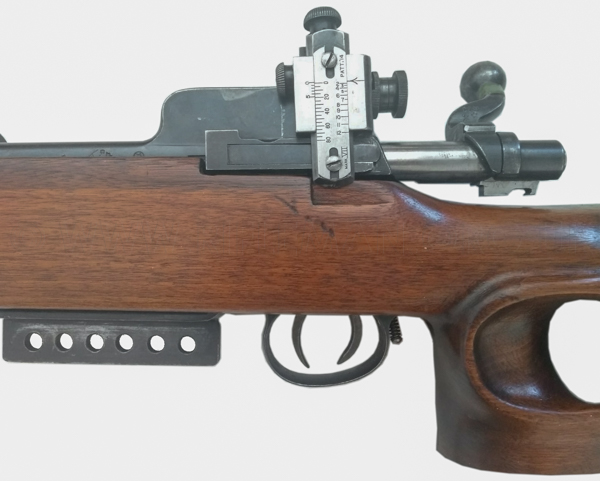
The vernier scale of the sight is marked " Mark VII" to denote the ammunition for which it is calibrated,
and "PATT. '14" to confirm the rifle for which it was designed.
The double set trigger and its adjustment screw can be clearly seen,
as can the bracket with adjustment holes for fitment of the rather elegantly styled hand rest show earlier.
The British National Rifle Association's Journal carried a contemporary article on the 1948 Olympic free rifle.
The article is replicated in the flip-page representation below.
As already mentioned, the initials "K-B" came from Knott & Broughton.
Broughton was an original partner, but the partnership broke up at some point. Mr. Saunders was not sure why.
Believed prior to the Enfield Pattern '14 .303-inch conversions came a rather unusual example of free-rifle modified by Knott from a considerably more rare Pattern '13 trials rifle.
This rifle is illustrated on our page for the Pattern 1913 Enfield trials rifle.
______________________________
At the time Mr. Saunders was working with Knott, most of the small-bore bolt-actioned rifle actions used were bought in from a German firm. He said the German firm's name sounded like "Gushlof" but again he could not spell it. He remarked that "we have seen Knott rifles also made on pre-war Mauser .22 actions - a great number of these rifles, and maybe actions, were brought into the UK not long after the war, and many were sold by Parker-Hale. We can recall them having a page in a P-H catalogue of around that time. Parker-Hale also made a special aperture sight to fit these rifles."
The stocks were made and finished in-house, mostly made by Mr. Cecil South, who also was a maker of ecclesiastic furniture.
Mr South had a special finishing formula which he kept secret,
making it at home and bringing the materials in to work - the secret was to die with him.
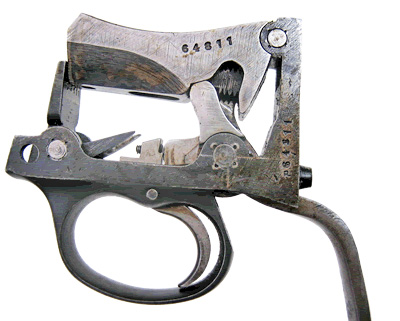 The triggers which, with the stocks, were considered to be the significant advance in the firm's production that generated their market, were also designed and made in house. The parts were sent to a firm in Kingston for cyanide-hardening, and then finished ("stoned square") by Mr. Saunders, who noted that the firm also manufactured their own design of set trigger.
The triggers which, with the stocks, were considered to be the significant advance in the firm's production that generated their market, were also designed and made in house. The parts were sent to a firm in Kingston for cyanide-hardening, and then finished ("stoned square") by Mr. Saunders, who noted that the firm also manufactured their own design of set trigger.
The serial numbers of Knott rifles were understood to represent the date the rifle was finished, but the s/n on the action (left) is probably that of the original BSA Model 12/15. Knott's trigger modification is evident though, with a grub-screw for adjustment.
This is a variation on the theme, a patent trigger pull-off,
originally marketed by A.G. and A.J. Parker and Parker-Hale
We have been kindly afforded photographs of one of Knott's Mauser-actioned .22 targets rifles.
It is here shown without sights

This rifle's action would bear comparison with the "Deutsche Sportmodell" Mauser style training rifle.
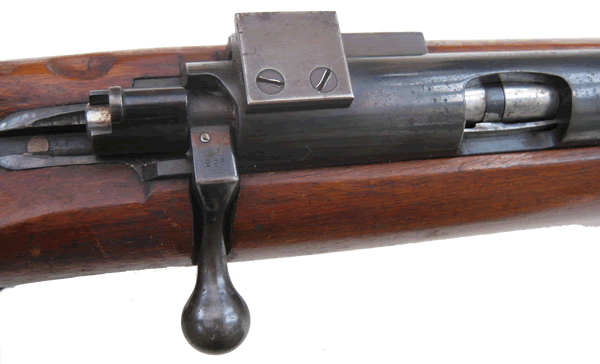
The stocks of Knott's rifles were beautifully made, with fine, practical curved lines and finish.
His stocker is mentioned in the texts further on.
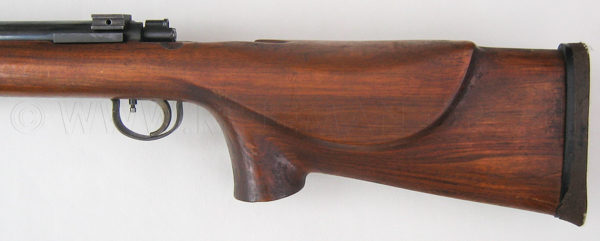
Below: typical barrel marks of Knott's rifle production
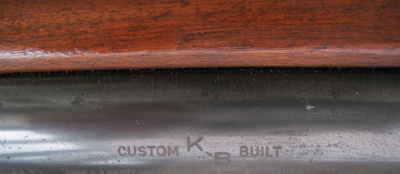 .........................
......................... 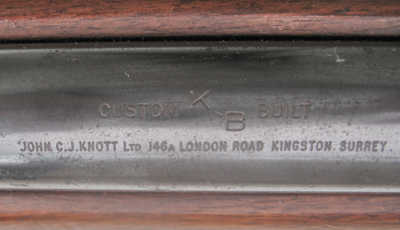
Knott favoured the adjustable front bedding ring that had become popular at the time,
and which could also be seen on such as some of the Parker-Hale Dewar rifles,
but did not utilise the additional electrical adjustment system used by some manufacturers,
an example of which is shown on one of the BSA Model 15 or Centurion rifles.
The left image shows the ring, with the two upper adjustment screw studs ................. and on the right is the fitting for the bottom screw
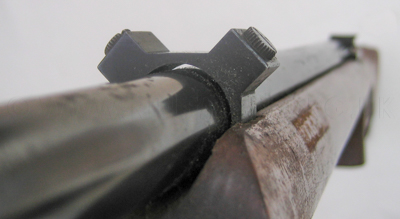 .........................
......................... 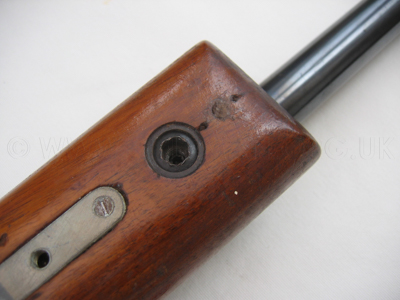
The pistol-grip and trigger arrangement
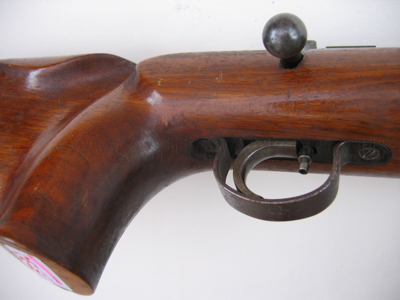
The bolt, from above and below
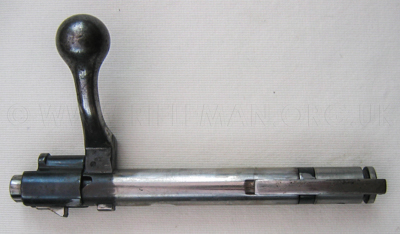 ..................
.................. 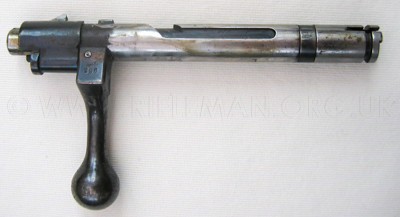
The bolt cocking indicator
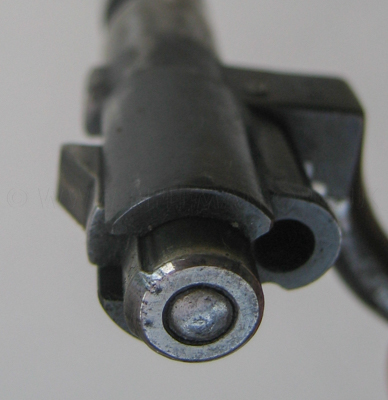
Another of Knott's .22 bolt-action rifles illustrates a significant change in design.
The receiver is machined to permit loading from either side, and it is believed that the barrelled action
was intended to be sold, with alternative stocking, for either left or right-handed use,
in much the same way as were some of those .22 target rifles produced by M.K. Jurek,
and the most unusual under-lever operated bolt-action Barnett "10X" rifles,
which were barrelled by the Ten-X Manufacturing Company.
The rifle is here shown without sights, and lacking the hooked adjustable alloy butt-plate,
but the sights are illustrated separately lower down this page.


The rear of the action, with the bolt open.
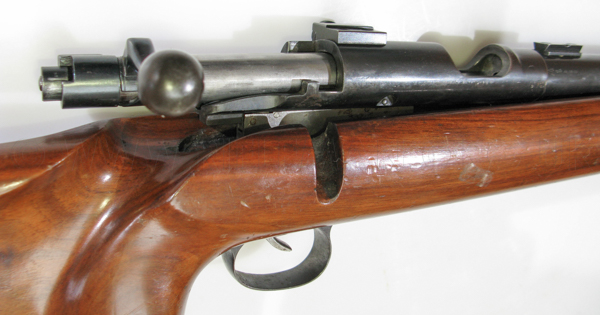
And from above, showing the notably formed cheek-piece design.

The barrelled round action is here removed from the stock,
showing the two hard bars within the bedding section.
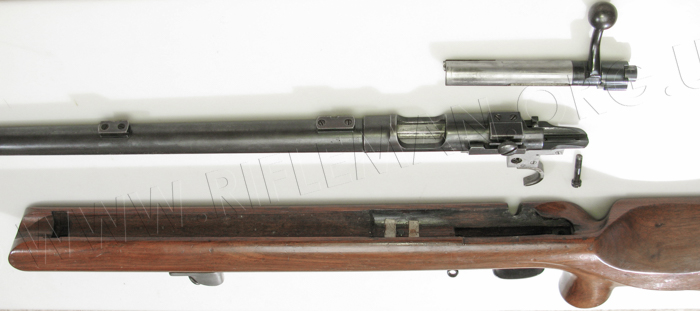
And the adjustable trigger mechanism bolted below the receiver.
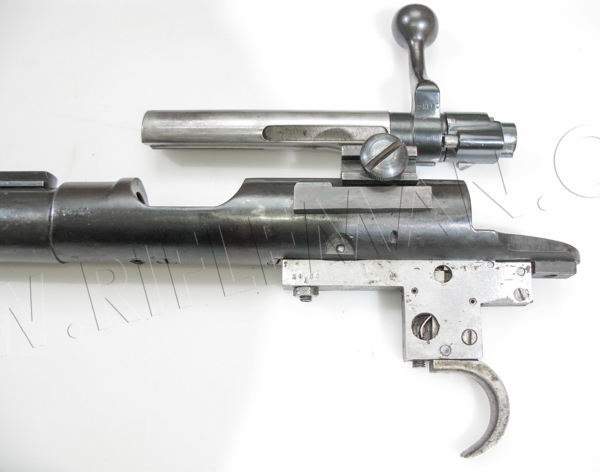
The bolt, from beneath., showing the sear release.
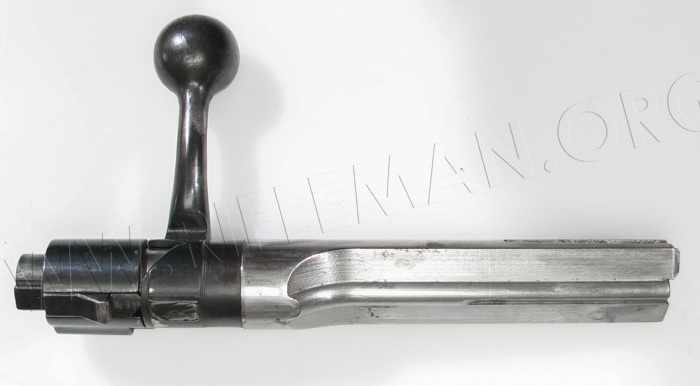
The bolt-head face, with unusually wide extractor.
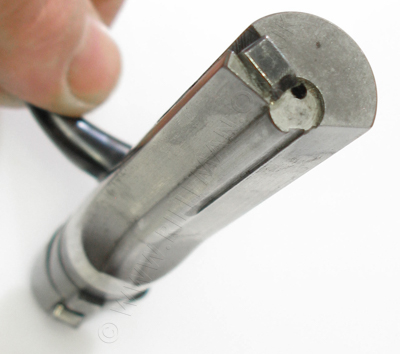
The stock's fore-end viewed from underneath, showing the forward bedding bolt,
the inlet "K-B" ivory cartouche, a proprietry hand-stop and accessory rail
such as found on the contemporary BSA Martini International rifles,
the two then tradional wood screw eyes for the sling hooks or swivels,
and, right at the front, the fitting for the lower adjusting screw previously discussed ,
the components for which are illustrated four images down.

The receiver loading platform, and rear-sight mounting block.
The rifle has also been fitted with the dovetail mounting blocks to permit use of a telescopic sight.
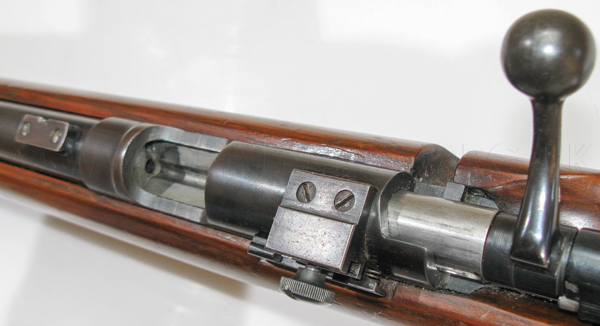
The barrel is characteristically marked with the "CUSTOM K-B BUILT" stamping,
underneath which is the company address at that time.
"JOHN C.J. KNOTT Ltd. 73, SURBITON ROAD, KINGSTON, SURREY."
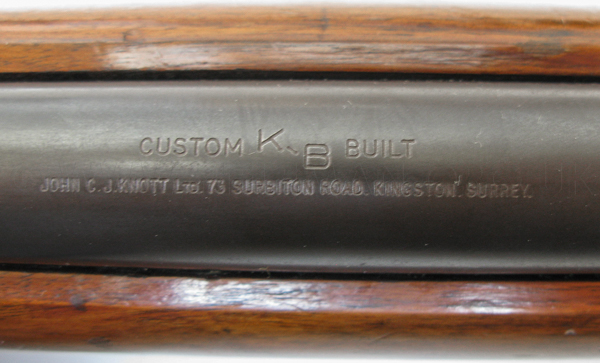
Note the relieving of the fore-end to accommodate the Freeland produced bedding ring.
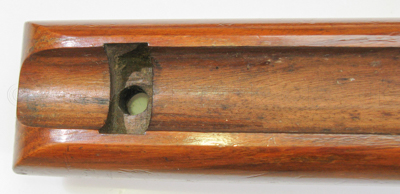 .........
......... 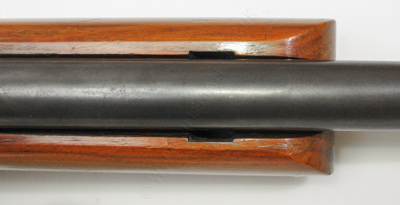
Which ring is illustrated below
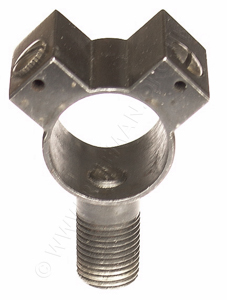 .......
....... 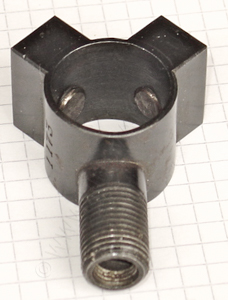 .......
....... 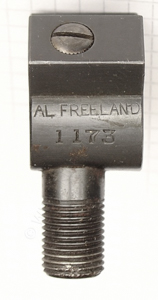
A close-up shot of the forward bedding bolt and the company cartouche.

Finally, we illustrate the sights.
The fore-sight is probably a contemporay product seen used on a number of competitors rifles,
but the rear-sight is of in-house manufacture.
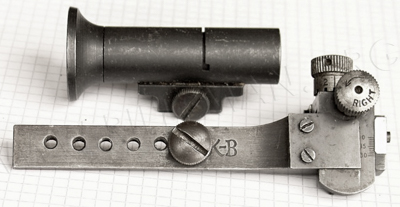
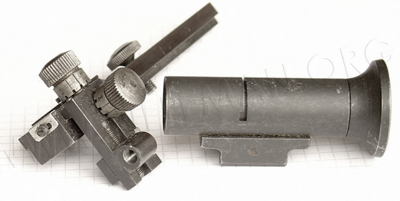

Below we show a cartoon printed in the Autumn 1952 Edition of "The Rifleman"
(which emerged early in the Twentieth Century as the quarterly journal of the Society of Miniature Rifle Clubs,
and remains to this day - post November 1947 - the mouthpiece of the National Small-bore Rifle Association).
The cartoon depicts well-known persons seen at the Bisley Small-bore Meeting of that year.
Col. Gould D.S.O., mentioned in Knott's obituary, is present (top right), as is Knott himself,
prominent again (centre) and described as being amongst the "Big Guns".
Another remarkable personage, that of John Hall, is shown (top left).
Hall worked for Eley in their .22 rimfire cartridge manufacture, both testing ammunition in the works and very successfully out on the range.
He appeared in the illustrious company of the highly successful Arthur Traes, Longhurst and A.G. Banks
on a pamphlet published by the S.M.R.C. "A Few Hints on Rifle Shooting" authoured by Capt. T.S. Smith.
He later competed in the 1964 Tokyo Olympics with the then new prototype of the B.S.A. Martini International - which became the Mark III.
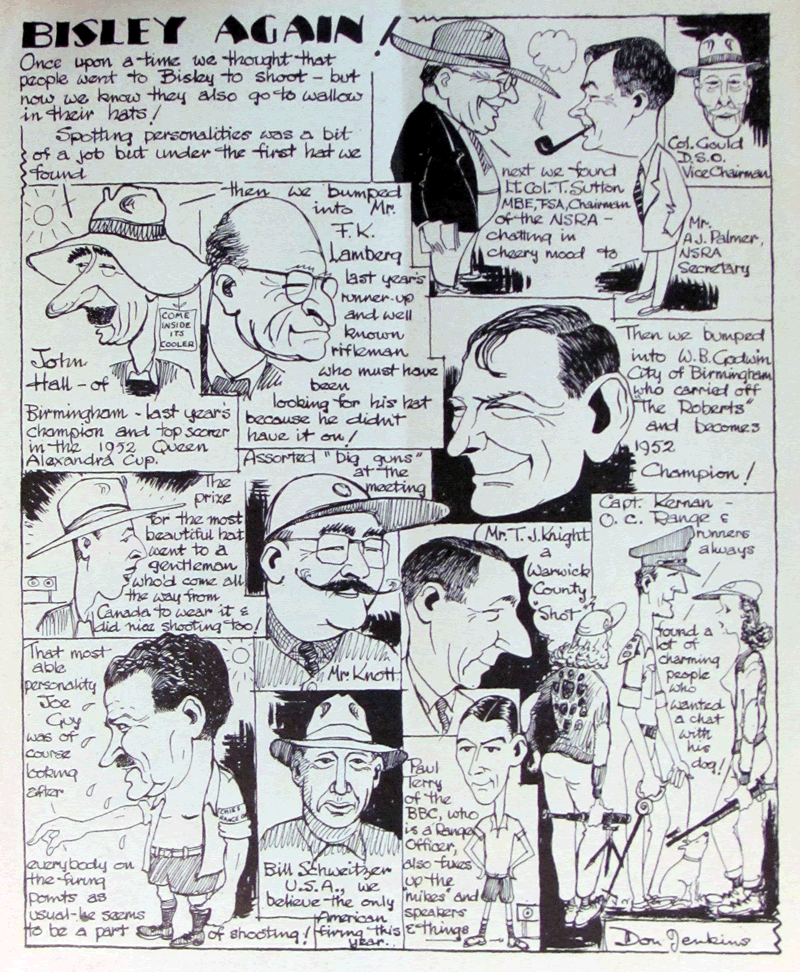
John Knott's expertise in full-bore rifle gunsmithing, as well as small-bore,
is to be found discussed within an article in "The Marksman".
It is about one of his game-shooting clients and her Mannlicher-actioned .303"CF hunting rifle.
Self-publicity? Perhaps.
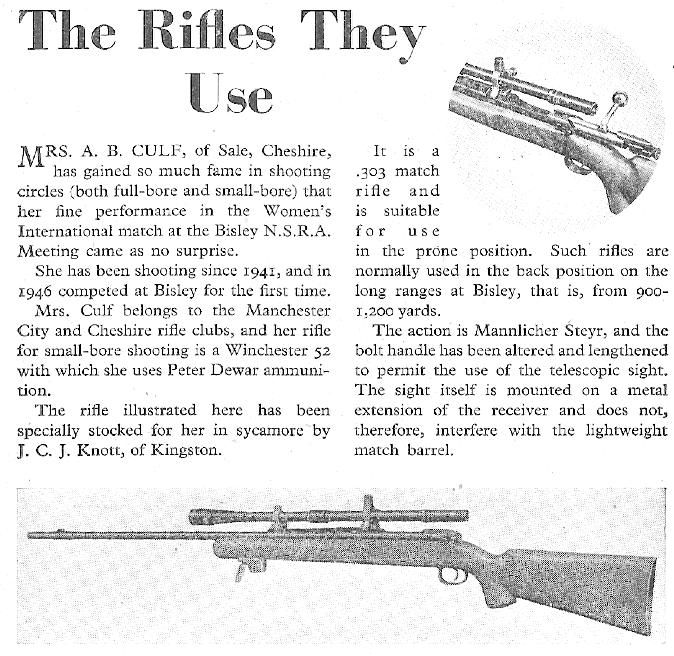
Knott's lady customer, Mrs. A.B. Culf of Sale, Cheshire, was evidently a versatile shooter;
also using a Winchester Model 52D .22RF target rifle to some effect during Bisley Week.
John Knott's family in the U.S.A., his two stepsons Ed and Jerry, have kindly provided additional detail and photographs for this article
and we are grateful to be able to add this to the information we have on John's time in the U.K.
Amongst much other material, we have been given photographs of the very last .22RF target rifle built by him,
and used regularly, usually with either a Unertl or Fecker telescopic sight.

Beautifully stocked, and showing only the 'scope mounts,
the rifle is fitted  with a 'five star' barrel by the well-known U.S. maker Eric Johnson *,
with a 'five star' barrel by the well-known U.S. maker Eric Johnson *,
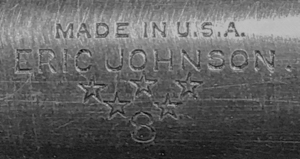
and has been serial numbered "1", presumably of type ..........
........... with his usual name engraved on the action.
The family believe that the burn mark was probably made as a result of their stepfather's penchant for cigars!
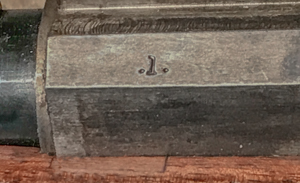 ..........................................
.......................................... 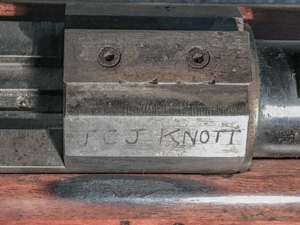
Knott also built a .280" Magnum calibre rifle, and was much into such 'wildcat' cartridges.
It was an interesting choice of calibre, perhaps influenced by the contemporary thinking
in military circles around that time, with the proposed introduction of such a cartridge, it having been experimented with
by Charles Ross on his straight-pull rifle, on the Enfield Pattern '13 Rifle, and on the EM-1 and EM-2 bull-pup service rifles.
The two 4 inch long belted-case cartridges above are each reminiscent of those used for the .55/.303" Boys Anti-Tank Training Rifle
and the .55-inch round for the service issue Boys Anti-Tank Rifle (originally "Stanchion"),
although, the .55" case alone is near 4 inches long, (and the soft-nosed bullet would have been highly unacceptable for other than hunting).
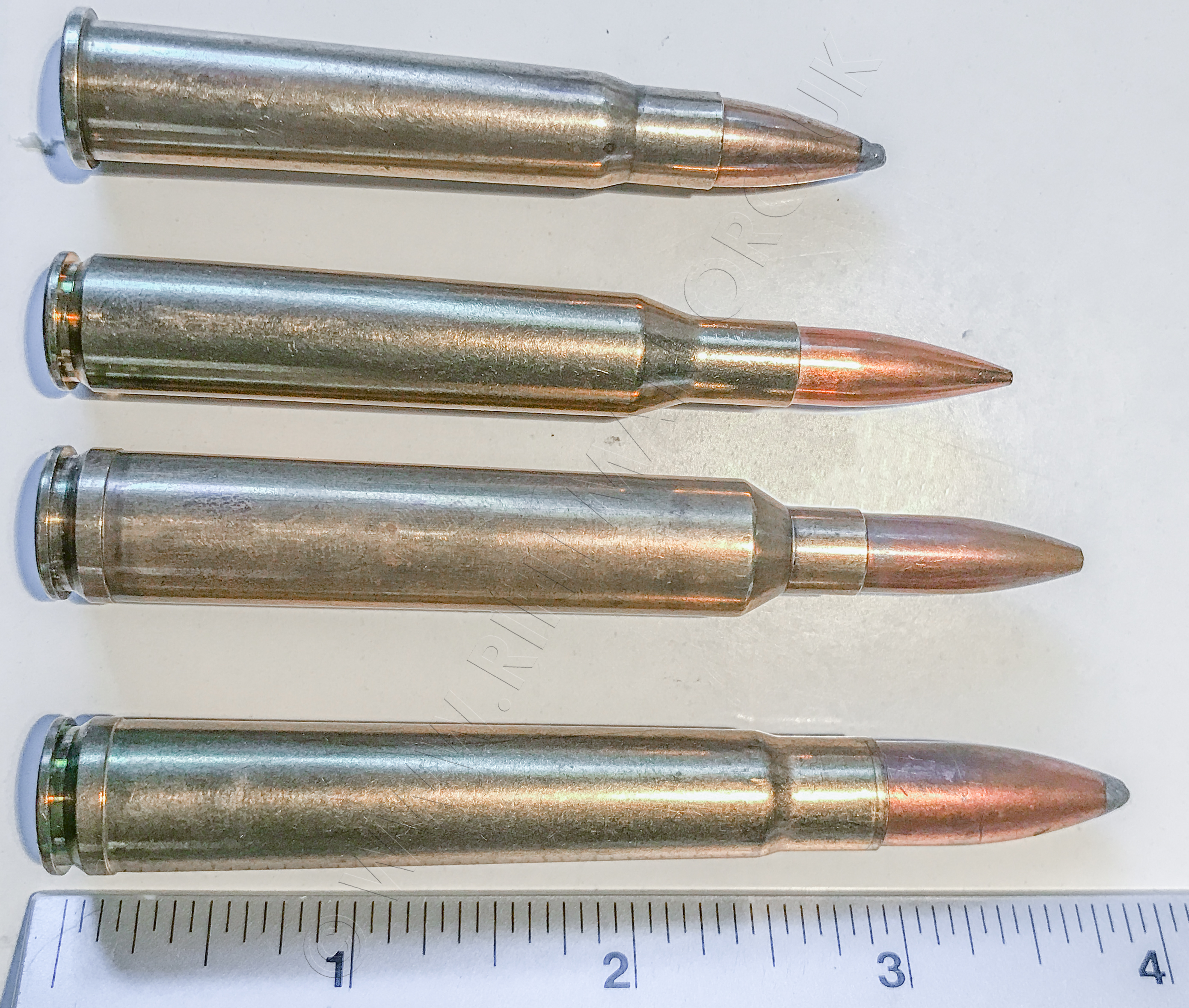
Detail of these cartridges was recently passed to us by John's stepson Ed,
who provided a dimensioned drawing of the .280 Magnum, which they called the "Black Mamba", and wrote as below:
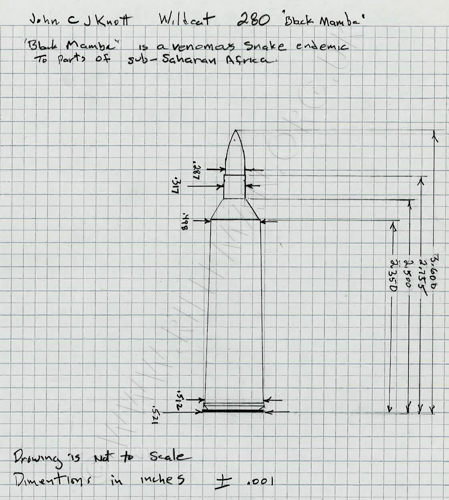
"The drawing dimensions are approximate, as they were taken using a hand caliper as close as I could get it by eye.
In the photo the cartridges from left to right are, 303 British,
Winchester 270,
280 Magnum,
300 H & H Magnum.
The 280 was made from 300 Magnum shells. The only part of the operation I remember was putting a 15 grains charge of Bullseye pistol power in and then filling the rest of the way with corn meal tamped down a little. Then it was fired in the rifle. That conformed the shell to the chamber although the shoulders were still rounded. The shell was then loaded with the proper charge and a bullet to finish its profile shape. I don’t remember how we shaped the shell at first to get it to go into the chamber. There must have been some pre-sizing.
I believe the normal charge we used was
96 grains of 50 MG powder with a
180 Grain bullet .
That was a long time ago so that may not be right. I am tempted to pull the bullet and weigh the thing just to confirm it.
There were at least two of the rifles made that I know of, possibly 3. One was a heavy barrel target rifle like the .22 target rifle. I remember shooting it in a 300 and 600 yard competition. It was fun to shoot, with a recoil that pushed you rather than jabbed you like a 30-06.
John also made a hunting version for someone. He also supplied the shells and reloading dies. It could have been the third one he used next to me in the competition.
After his death I was able to get the .22 rifle, but the .280 vanished. I hope someone didn’t put the wrong shells in it. There were no markings on it that I know of. I do remember he used a Mauser action for the target rifle.
The chamber reamers were given to Roy Dunlap a long time ago. My brother Ed mentioned John working for Roy Dunlap, who was a prominent American gunsmith at the time. I think I remember it being said that he sponsored John when he came to the US to work for him. I wouldn't be surprised if Roy met John at the Camp Perry shoot. "
"Roy Dunlap only lived a few miles away. John seemed to have a positive connection with him. I vaguely remember an article the newspaper did about John and Roy; John being the shotgun expert and Roy being the rifle expert. We can probably find that article by contacting the two newspapers in Tucson. It was in the late 50s or early 60s so they should have it in their archives. This indicated a shift of John's focus from rifles to shotguns. As well as customising rifles, there were a few unique things that he did to customise shotguns! "
The 1961 article mentioned was found, is very informative, and we have transposed it
into text from a very poor PDF document to make it legible on screen.
TUCSON DAILY CITIZEN (Arizona, U.S.A.) - SATURDAY, OCTOBER 14, 1961
By BILL DAVIDSON
GUNNING IN TWO DIRECTIONS
ROY DUNLAP - Pace-setter in free rifle work.
Tucson’s shooting and hunting fraternity aside, few people realize that two of the nation’s better-known gunsmiths operate here. They are Roy Dunlap, internationally-known builder of Olympic-style match, or “free,” rifles, and John C. J. Knott, English-trained specialist on shotguns.
Both work out of shops at home—Dunlap at 2319 E. Ft. Lowell Rd., Knott at 2226 N. Euclid Ave. Both operate in what would appear to the uninitiated to be welters of confusion, a seemingly hopeless jumble of machine tools, woodworking machinery, chemical tanks and rows upon rows of small tools.
That similarity taken care of, they’re otherwise fairly different. They reached eminence in their craft from quite separate approaches. Knott grew up in a gun-minded family. His father gave him a .45-calibre GI service pistol at the incredible age of five, made him learn to strip it (but wouldn’t allow him to shoot it). He went to his maternal grandparents’ home in England at the age of 8, at first for treatment of a game leg suffered in a fall off a horse.
He stayed there and became apprenticed into his family’s gun shop. In the pre-war 1930’s, the shop turned out .404-cal. rifles on contract for the famous old English gun firm of Jeffery; these were destined for East Africa game fields and use by British- trained native guides and scouts. World War II put the firm temporarily out of business.
Knott served in the British paratroops, then reopened the shop after the war. He turned out more .404s for the colonies and helped initiate the use of bolt-action .22 match rifles in Britain. Before the war, British smallbore target shooters had largely used single-shot match rifles. He went in for smallbore competitive shooting in a big way, fired in and won several international matches and shot for Britain in the 1948 Olympics.
Knott returned to the U.S. in 1953 as a member of the British Pershing Trophy rifle team firing at Camp Perry, Ohio, decided to sell out at home and emigrate back to this country. He came to Tucson after a stint in the Washington, B.C. area, worked for Dunlap for a time until starting his own shop here. At first, he went for wildcat (gunsmith-developed, non-standard) rifle cartridge development. But a few years ago, he noticed something many other competent gunsmiths seemed to have ignored or missed - there is considerable financial reward in the customizing of trapshooters’ guns. More, he feels, than in most other fields of gun work. Knott states his case flatly: “The rifle boys are as poor as I am. The better money now is in gunsmith work for trapshooters.” He points to the relatively well-bankrolled shooters who follow the winter tourist and trap circuit, and to equally well-off winter visitors to this area - many of them trapshooters - as evidence.
Knott’s specialty is customizing the Model 12 Winchester pump shotgun, although he does refurbishing of all kinds of guns, and particularly all kinds of shotguns. A typical custom shotgun job costs about $300 and requires 60 days. He also continues some rifle work, however, and is becoming more interested in tuning up handguns, especially for double action, combat-style shooting. “One point that surprises me,” he says, and this backs up his theory about the well-bankrolled trap-shooter, “is how many really high-grade shotguns keep turning up in the shop. A large part of my work the last few years has been manufacturing parts for fine old British guns—such as Woodward’s, Churchill’s, and Boss’s.” He thinks this is testimony to the economics of his argument about trapshooting and shotgun work generally.
Photo (poor) - JOHN C. J. KNOTT Customizing for trapshooting
Since “discovering” the trap circuit, Knott has branched out from customizing guns for a few local shooters to following the circuit through the Southwest—although arthritis has kept him home lately. “The first time I went out of town on the circuit, I got more work than I could handle—in Phoenix. Then I went to Las Vegas and worked 48 hours around the clock.” It apparently was worth it.
Dunlap grew up in the Chicago area. He gravitated into gunsmithing “because I couldn’t afford to have someone else fix my guns the way I wanted ‘em done,” he says. Reared by a hunting father, Dunlap became deeply interested in target shooting. He had machine- tool assembling experience but little else in the way of training for gun work. How did he convert this skimpy experience into a career as one of the world’s best-known gunmakers?
“I bought this machinery,” Dunlap said, waving a hand at a machine-shop-full of lathes, presses and innumerable other rigs. But how’d you learn to use them? “I turned ‘em on.”
Dunlap has lived in Tucson since 1946, after a service stint of globe-circling proportions. He originally worked here for now-defunct Buck’s Sports Shop, where Carmichael’s now is located. He went into business for himself in 1948. By the early 1950’s, he started to acquire an international reputation as a builder of precision target rifles. Dunlap’s developments in free rifle work set the pace and the pattern for similar rifles later brought out by the U.S. two top mass-production riflemakers, Remington and Winchester. Free rifles introduced by them a few years back incorporated many Dunlap features. Even now, he supplies many of the parts, on subcontract, for the big companies’ international match rifles. But the bulk of his work for years has been producing free rifles in both smallbore and big-bore calibres for the Army which, since the Korean War’s bitter lessons in marksmanship, has demonstrated an increasing interest in shooting.
Dunlap has also been one of the country’s better-known and more accomplished target marksmen for several years. He annually makes a pilgrimage back to the national matches at Camp Perry to (a) shoot; (b) show his wares; and (c) consult with other top shooters and check on other products in his line.
On the side, Dunlap has written three books in his field, along with a rash of articles, on both shooting and the technical intricacies of gunsmithing, for the American Rifleman and other outdoors publications. Typical of Dunlap, he titled his best-known, book on gunsmithing “Gunsmithing/ 1.
While the military, notably the Army’s Advanced Marksmanship Unit shooters at Ft. Benning, Ga., are his top customers, he has some others. One of the more famous is the Maharajah of Bikaner, in India, one of the current godfathers of competitive shooting in that country. Dunlap outfitted the maharajah with a couple of match rifles, and the delighted customer helped launch India into international shooting. The dignitary was so impressed, both with his own efforts and those of other Indian shooters, that he had published a private brochure on Indian shooting at the international level. “It’s a better publishing job than the U.S. did on the international matches that year,” Dunlap commented.
American shooters in the last few years have demonstrated increasing interest in international shooting, partly because of the challenge for sports supremacy posed by the Communist world. So far, the U.S. hasn’t done as well as expected, but when it has succeeded, or scored highly, the job has been done to a large degree with rifles, or ideas developed or helped along by Dunlap."
Another 1961 Tucson article, just about legible, related only to John Knott, covering the setting up of his new gunshop, and proposed charity work.
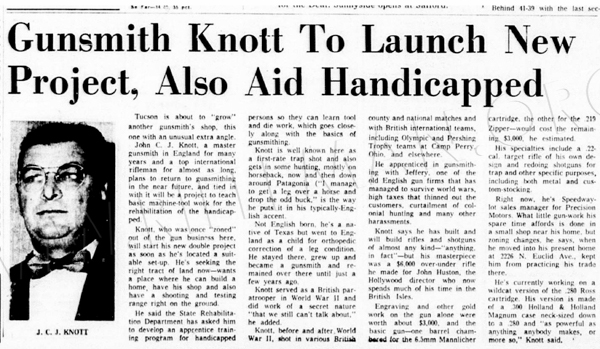
Note that the following four photographs are copyright to the family.
Below: Mary Knott, John's wife, in his gunshop.
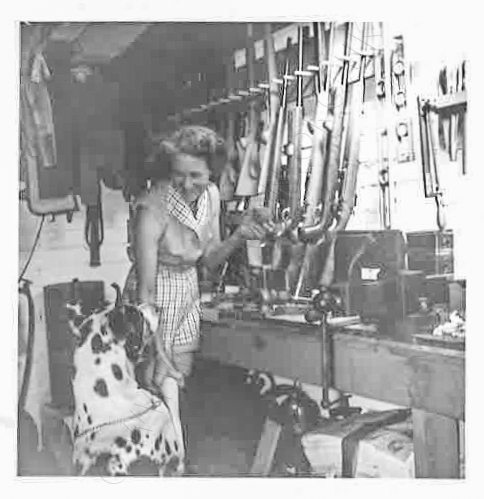
John shooting an M1 Garand in Mexico.
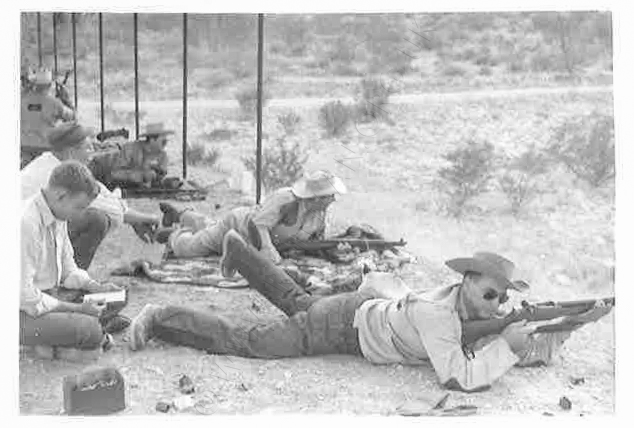
On a hunting trip in Patagonia (far left).
(May that be his .280 Magnum hunting rifle?)
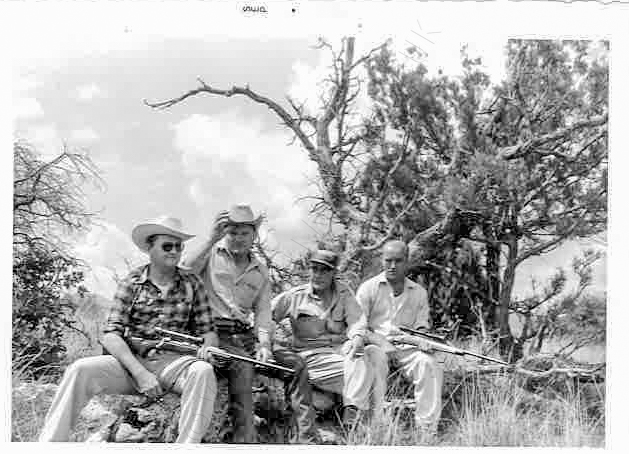
And with Mary and his stepson on the range in Tucson, Arizona.
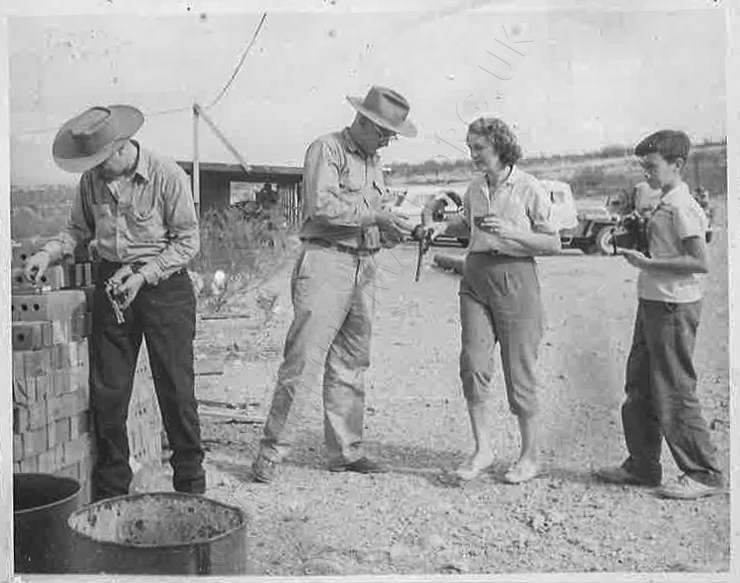
THE LAST FOUR EDITIONS of THE MARKSMAN JOURNAL
These are searchable flip-page facsimiles of the journal, may take a few moments to display. N.B. The search magnifier may need to be clicked twice.
JULY 1950 - Vol.1 No.1
SEPTEMBER 1950 - Vol.1 No.2
OCTOBER 1950 - Vol.1 No.3
NOVEMBER 1950 - Vol.1 No.4
* The American Single Shot Rifle Association has Eric Johnson's shop records and for $10 will TRY to research a rifle.
Their archivist is Rudi Prusok, and for further information email: rprusok@nmu.edu
Return to: TOP of PAGE
See this website's Raison d'être
